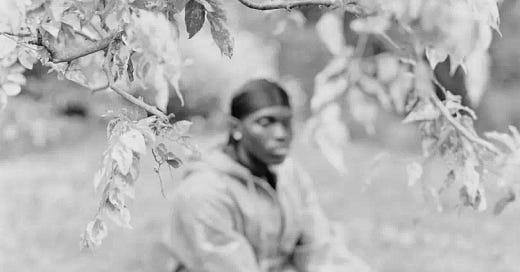And the days are not full enough: Donavon Smallwood Interviewed by Thomas Dunn
Donavon Smallwood discusses his experiences growing up in New York City as a photographer and how the artist balances the troubled history of Seneca Village with his deep love for Central Park.
After viewing Jim Goldberg’s entrancing retrospective at Pier 24 Photography, stepping into Donavon Smallwood’s Languor, I felt an immediate sense of relief.
As I walked around the room, the large black and white photographs became their own religious experience. Every portrait was meditative—a place of reflection and resistance. Central Park, where all Smallwood’s photographs in this exhibition were taken, felt unfamiliar to the Central Park I know. The room was its own beautiful planet, enticing me to linger with the images and in this space.
I had an opportunity to catch up with Smallwood to discuss his experiences growing up in New York City and how the artist balanced the troubled history behind Seneca Village with his deep love for Central Park while making Languor.
Thomas Dunn: You said you’re in New York right now–are you from there?
Donavon Smallwood: Yes. I was born and raised in Harlem, New York.
TD: What was it like growing up in the city?
DS: I don’t know, it’s tough because everything [about growing up in New York] to me seems so normal. But when I hear about other people’s experiences growing up outside of New York, it’s so different. For me, growing up we had a lot of freedom, I guess.
Once you hit middle school, you get a Metro card and you use the card not just to go to school, you can go wherever you want. There’s so much to do here. There’s so much culture. As a kid I got to experience so much and it felt kind of normal. When I started going to other places that weren’t walkable or as diverse, I was like “oh this is the whole world isn’t like this.”
TD: Any places you loved to go?
DS: I would either go to the Chinatown area, Canal Street, or I would go just take the subway. I wouldn’t go that far. I would end up either doing that or going to Coney Island, which is really far from where I lived. I also went to Central Park, which is right across from where I am now. I would take the bus and go to Central Park and just hang out in the park all day.
TD: I love that. When did you first become interested in art and photography?
DS: I got more interested in art and photography through the internet. Growing up, I actually wanted to be an archaeologist and a poet. My whole plan was to become a guy who travels the world, goes on digs, and finds things.
It was my whole identity up until I turned 16 and I took a digital photography class. Because I wanted to be good at it, I started looking up photography online and tried to figure out how to get better images than the other kids. I fell in love with it.
I remember the teacher telling me that the interest that I have in archaeology and anthropology was similar to photography because as an archaeologist, you’re searching through different cultures while looking at artifacts. I relate that to photography and photographing the unknown qualities of people or different communities.
Later when I looked up National Geographic, I was like, “Okay, yeah, I kind of see that.” And I just stuck with photography from then on.
Read the full interview about Smallwood’s installation in Turning the Page at Pier 24 Photography in San Francisco on Variable West.
Sign up to get writing on the best West Coast art sent straight to your inbox:





